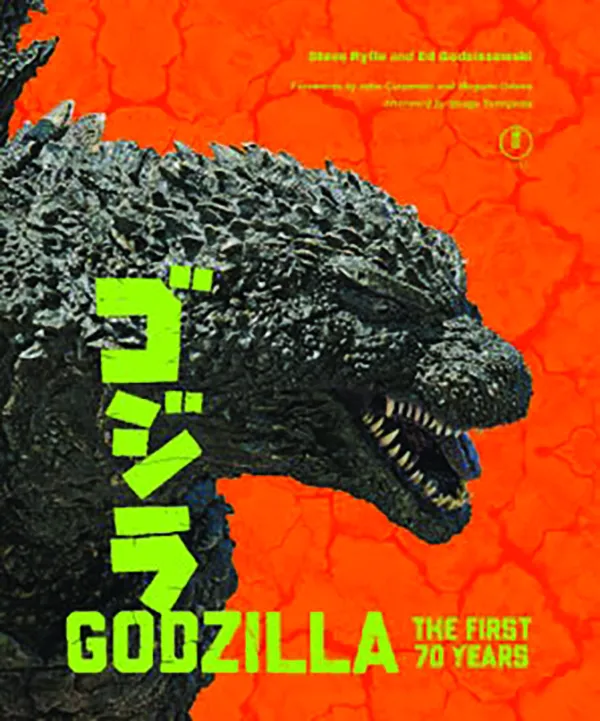Godzilla has terrorized the Land of the Rising Sun for decades. Known as a kaiju (monster) in Japan, and King of the Monsters in the United States, Godzilla’s fearsome roar and atomic breath is a child’s nightmare come to life. It’s fought with and against other gigantic creatures. It’s struck fear in the hearts of panicked citizens. It’s a legendary presence on the silver screen.
Godzilla may be a fearsome kaiju, but it’s a beloved character in the history of cinema, going back seven decades. Steve Ryfle and Ed Godziszewski’s Godzilla: The First 70 Years celebrates this important milestone of one of Japan’s greatest creations. The entire history of the Japanese productions (and several American film adaptations) is covered, complete with illustrations, interviews and behind-the-scenes images. It’s not only a magnificently designed volume for display on coffee tables and personal libraries, but an invaluable research tool.
As American director John Carpenter writes in one of the book’s forewords, “Godzilla is everything. He’s an all-purpose monster. He takes care of business. He’s fought everybody from King Kong to King Ghidorah … I am nostalgic for the look and feel of the original films, the ones I grew up with and raised my son on.” Japanese actress Megumi Odaka, who’s appeared in six Godzilla films, crafted a deeply personal foreword. “I hope that when people watch Godzilla … they can appreciate the feelings and intentions that were in our hearts,” Odaka noted. “Godzilla is something that can’t be completely defined in words – it means something different to each one of us.”

With such passionate descriptions, it’s startling to think this could have easily ended up being a one-off creature flick. The 1954 film Godzilla focused on a monster that was “created to entertain,” but its “arrival was foreshadowed by history-changing events.” Japan was “just nine years removed from the twin atomic bombings,” and the difficult Second World War memories were still fresh. Conversely, Toho Studios, the production company behind Godzilla’s success, was in crisis. Its first-ever color feature, In the Shadow of Honor, which was going to be filmed in Indonesia, was canceled due to disagreements between the two countries related to colonial war reparations. Producer Tomoyuki Tanaka was under pressure to “create a replacement of equal commercial prospects” — and quickly.
“I was up against a deadline when I first thought of Godzilla, and I made it all up at the last minute,” Tanaka recalled. He wanted to do something with the ocean, and there were intense discussions in Japan about nuclear testing. “What if there was this big monster near Bikini which was awakened by the shock of hydrogen bomb testing,” he thought. “And what if that monster invades Japan?” The box office success of King Kong’s 1952 rerelease, followed by Eugene Lourie’s The Beast from 20,000 Fathoms (1953), where a dinosaur was awakened by an atomic blast, both served as inspiration. Toho gave the green light to Godzilla under the “cryptic” working title G Project. Legendary director Ishiro Honda and composer Akira Ifukube were brought in, and movie magic was about to be made.
Who came up with the name “Godzilla” Believe it or not, there’s no definitive answer. It could have been derived from Jira Monster, a 1952 story written by Shigeru Kayama about a lizard-like creature that caused mayhem on a Pacific island. An idea for a film about a giant whale or kujira is a possibility. Tanaka suggested it was Gojira, a “compound of gorira (gorilla) and kujira” — and the nickname of a Toho Studios employee.
The origins of Godzilla’s name may remain a mystery, but there are no secrets related to its film escapades. Godzilla: The First 70 Years contains impeccable research and analysis, accompanied by fascinating photos of the sets, film crews, and casts. Seeing directors standing next to a costumed Godzilla (played by Haruo Nakajima for the first 12 films) certainly brings the fantasy back into reality with one fiery atomic breath.
The films are succinctly dissected, too. Godzilla Raids Again (1955), a sequel “rushed into production” after the immense success of Godzilla, introduced his first ancient foe, the dinosaur-like Anguirus, and brought two talented actors in kaiju films, Hiroshi Koizumi and Yoshio Tsuchiya, into the fold. King Kong vs. Godzilla (1962) was the first battle between the two legendary monsters, and has been followed by American releases Godzilla vs. Kong (2021) and Godzilla x Kong: The New Empire (2023). But Godzilla has been fighting other giant monsters on film since soon after his creation.
SYDNEY SWEENEY GOES WESTERN IN ‘AMERICANA’
Newer Godzilla films have transformed the beloved kaiju from a cult following to a highly respected fictional creature. Shin Godzilla (2016), Toho’s third reboot of the mighty monster, was praised by Japanese movie critics due to its “completely new origin story in which Godzilla functions less as a living creature and more like a walking natural catastrophe of world-ending scale.” The most recent release, Godzilla Minus One (2023), successfully personalized “Godzilla’s symbolic representation of war and death to achieve an emotional link between the protagonist and monster that no other film has attempted.” It became the first Godzilla film to be nominated for an Oscar, which it won for special effects.
Few characters, real or imaginary, have sustained this type of stage and screen presence for so many decades. May the King of the Monsters rule Japanese cinema for another 70 years.
Michael Taube, a columnist for the National Post, Troy Media, and Loonie Politics, was a speechwriter for former Canadian Prime Minister Stephen Harper.























